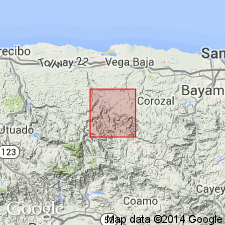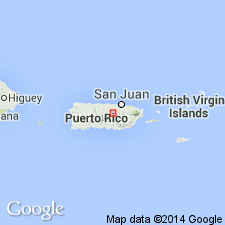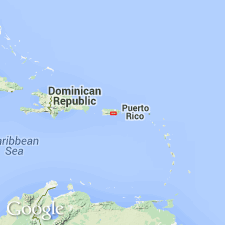
- Usage in publication:
-
- Magueyes Member*
- Modifications:
-
- Named
- Dominant lithology:
-
- Lava
- Breccia
- AAPG geologic province:
-
- Caribbean region
Summary:
The Magueyes Member of the Rio Orocovis Formation [of Weaver (1964) and Lidiak (1965)] is here accepted for USGS use. Contains a lower sequence of amygdaloidal basaltic pillow lava, pyroclastic volcanic breccia, and lava flows, and an upper sequence of massive pillowed lava flows with lenticular layers of reworked(?) tuff. The sequences are separated by tuff of the basalt tuff member of the Rio Orocovis. Gradationally underlies the Perchas Lava Member. Age is Turonian(?) to late Santonian(?) or early Campanian.
Source: GNU records (USGS DDS-6; Reston GNULEX).

- Usage in publication:
-
- Magueyes Formation*
- Modifications:
-
- Revised
- AAPG geologic province:
-
- Caribbean region
Summary:
Rio Orocovis Formation redefined Rio Orocovis Group and Magueyes Member redefined Magueyes Formation. Is lower unit of the Rio Orocovis; underlies the Perchas Formation.
Source: GNU records (USGS DDS-6; Reston GNULEX).

- Usage in publication:
-
- Magueyes Formation*
- Modifications:
-
- Revised
- AAPG geologic province:
-
- Caribbean region
Summary:
In the Barranquitas quadrangle the Magueyes Formation contains a basal member, the here named Barrancas Limestone Member (the limestone unit of formation L); a tuffaceous sandstone and siltstone unit (of formation L); a basalt lava unit that may be a tongue of the Perchas Formation, and strata correlated with the Cariblanco Formation. Overlies rocks tentatively correlated with the Torrecilla Breccia. Age is Early and Late Cretaceous.
Source: GNU records (USGS DDS-6; Reston GNULEX).

- Usage in publication:
-
- Magueyes Formation*
- Modifications:
-
- Age modified
- AAPG geologic province:
-
- Caribbean region
Summary:
The Magueyes Formation occurs in central Puerto Rico and consists of tuffaceous sandstone and siltstone intercalated with pillowed basaltic lava flows and flow breccia, and, near the top, a thick basaltic hyaloclastite breccia. The lowermost part of the formation is the Barrancas Limestone Member. Maximum estimated thickness of formation is 1400 meters. The age of the Magueyes is changed to Early Cretaceous.
Source: GNU records (USGS DDS-6; Reston GNULEX).
For more information, please contact Nancy Stamm, Geologic Names Committee Secretary.
Asterisk (*) indicates published by U.S. Geological Survey authors.
"No current usage" (†) implies that a name has been abandoned or has fallen into disuse. Former usage and, if known, replacement name given in parentheses ( ).
Slash (/) indicates name conflicts with nomenclatural guidelines (CSN, 1933; ACSN, 1961, 1970; NACSN, 1983, 2005, 2021). May be explained within brackets ([ ]).

